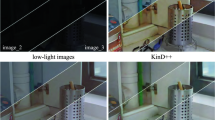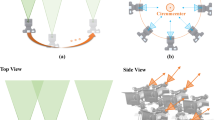Abstract
The distribution of incident light is an important physics-based cue for exposing image manipulations. If an image has been composed from multiple sources, it is likely that the illumination environments of the spliced objects differ. Johnson and Farid introduced a proof-of-principle algorithm for a forensic comparison of lighting environments. However, this baseline approach suffers from relatively strict assumptions that limit its practical applicability. In this work, we address one of the biggest limitations, namely the need to compute a lighting environment from patches of homogeneous material. To compute a lighting environment from multiple-color surfaces, we propose a method that we call “intrinsic contour estimation” (ICE). ICE is able to integrate reflectances from multiple materials into one lighting environment, as long as surfaces of different materials share at least two similar normal vectors. We validate the proposed method in a controlled ground-truth experiment on two datasets, with light from three different directions. These experiments show that using ICE can improve the median estimation error by almost 50 %, and the mean error by almost 30 %.









Similar content being viewed by others
Notes
Both datasets, are available from our lab’s web page http://www5.cs.fau.de/.
References
Brian V, Funt Mark S, Drew MB (2005) Recovering shading from color images. In: European Conference on Computer Vision, pp 124–132
Conotter V, O’Brien JF, Farid H (2012) Exposing digital forgeries in ballistic motion. IEEE Trans Inf Forensic Secur 7(1):283–296
De Carvalho TJ, Riess C, Angelopoulou E, Pedrini H, Rocha A (2013) Exposing digital image forgeries by illumination color classification. IEEE Trans Inf Forensic Secur 8(7):1182–1194
Fan W, Wang K, Cayre F, Xiong Z (2012) 3D lighting-based image forgery detection using shape-from-shading. In: Proceedings of the 20th European Signal Processing Conference (EUSIPCO-2012). Bucarest, Romania, pp 1777–1781
Farid H (2011) Digital Image Forensics. http://www.cs.dartmouth.edu/farid/downloads/tutorials/digitalimageforensics.pdf
Forsyth DA, Ponce J (2003) Computer vision — a modern approach. Pearson Education Inc
Gehler PV, Rother C, Kiefel M, Zhang L, Schölkopf B (2011) Recovering intrinsic images with a global sparsity prior on reflectance. In: Advances in Neural Information Processing Systems (NIPS 2011), vol 24. Granada, Spain, pp 765–773
Grosse R, Johnson M, Adelson E, Freeman W (2009) Ground truth dataset and baseline evaluations for intrinsic image algorithms. In: Proceedings of the 12th IEEE International Conference on Computer Vision (ICCV 2009), Kyoto, Japan, pp 2335–2342
Johnson M, Farid H (2007) Exposing digital forgeries in complex lighting environments. IEEE Trans Inf Forensic Secur 2(3):450–461
Kee E, Farid H (2010) Exposing digital forgeries from 3-D lighting environments. In: Proceedings of the 2nd IEEE International Workshop on Information Forensic Security (WIFS, WA, USA, p 2010
Kee E, O’Brien J, Farid H (2013) Exposing photo manipulation with inconsistent shadows. ACM Trans Graph 32(4):28:1–12
Kee E, O’Brien J, Farid H (2014) Exposing photo manipulation from shading and shadows. ACM Trans Graph 33(5):165:1–21
Ostrovsky Y, Cavanagh P, Sinha P (2005) Perceiving illumination inconsistencies in scenes. Perception 34(11):1301–1314
Peng B, Wang W, Dong J, Tan T (2015) Improved 3D lighting environment estimation for image forgery detection. In: Proceedings of the 7th IEEE International Workshop on Information Forensics and Security (WIFS, Rome, Italy, p 2015
Redi J, Taktak W, Dugelay JL (2011) Digital image forensics: a booklet for beginners. Multimed Tools Appl 51(1):133–162
Riess C, Angelopoulou E (2010) Scene illumination as an indicator of image manipulation. In: Proceedings of the 12th International Conference on Information Hiding (IH 2010), vol. Lecture Notes in Computer Science 6387, AB, Canada, pp 66–80
Riess C, Pfaller S, Angelopoulou E (2015) Reflectance normalization in illumination-based image manipulation detection. In: International Workshop on Recent Advances in Digital Security: Biometrics and Forensics, pp 3–10
Shen L, Yeo C (2011) Intrinsic images decomposition using a local and global sparse representation of reflectance. In: Proceedings of the 24th IEEE Computer Society Conference on Computer Vision and Pattern Recognition (CVPR 2011), CO, USA, pp 697–704
Zhang W, Cao X, Qu Y, Hou Y, Zhang C (2010) Detecting and extracting the photo composites using planar homography and graph cut. IEEE Trans Inf Forensic Secur 5(3):544–555
Acknowledgments
This work was supported by the Research Training Group 1773 “Heterogeneous Image Systems”, funded by the German Research Foundation (DFG).
Author information
Authors and Affiliations
Corresponding author
Additional information
This work was supported by the Research Training Group 1773 “Heterogeneous Image Systems”, funded by the German Research Foundation (DFG).
Appendices
Appendix
ᅟ
Intrinsic dataset error due to indoor illumination
We perform an error calculation to illustrate the effect of a light source at finite distance, as used for capturing both datasets. A light source at a finite distance effectively casts a cone of light. Assuming that object normals are selected from a light cone of 50cm diameter around the object center, only the central ray of the cone is with exactly the same angle incident to the object as if the rays were parallel. The maximum angular deviation of a ray incident to the object is
which occurs at the outer boundary of the cone. Under the method’s assumption of Lambertian reflectance, this error propagates into the cosine between the ray direction and the surface normal. The derivative (and hence variation) of the cosine is maximum at π/2, with sin(π/2)=1. Distributing the error symmetrically around π/2 leads to a upper bound of the intrinsic dataset error of
This worst case bound occurs if a normal is located at the cone-beam boundary and is directed orthogonally to the light source. If a normal lies at the cone beam boundary but points towards the light source, the intrinsic dataset error is negligible, i. e.,
Similarly, the closer a normal is to the center of the cone-beam, the smaller is its estimation error. In other words, normals that are orthogonal to the light source and located at the cone boundary exhibit the same intensities as if the light source-contour angle were 90°+9.44°≈100° degrees under an infinitely distance light source. All normals that do not adhere to both of these conditions exhibit a lower error, with minima at the center of the cone-beam or whenever normals are parallel to the central ray of the light source.
Performing the same calculation for the flash dataset yields ϕ max,flash = 9.04° for the closest (“ 0°”) light source, and ϕ max,flash = 6.20° for the most distant (“ 60°”) light source. The maximum errors e orth,flash are therefore 9.03° and 6.20°, respectively. The minimum errors e towards,flash are 0.36° and 0.17°, respectively.
Rights and permissions
About this article
Cite this article
Riess, C., Unberath, M., Naderi, F. et al. Handling multiple materials for exposure of digital forgeries using 2-D lighting environments. Multimed Tools Appl 76, 4747–4764 (2017). https://doi.org/10.1007/s11042-016-3655-0
Received:
Revised:
Accepted:
Published:
Issue Date:
DOI: https://doi.org/10.1007/s11042-016-3655-0




